![]()
![]()
![]()
Use LEFT and RIGHT arrow keys to navigate between flashcards;
Use UP and DOWN arrow keys to flip the card;
H to show hint;
A reads text to speech;
57 Cards in this Set
- Front
- Back
|
Djurab Desert, Republic of Chad
|
Place where Sahelanthropus tchadensis was discovered by Brunet's team in 2001 |
|
|
Middle Awash / Aramis, Ethiopia
|
Place where fossils of Au. afarensis, A. kadabba, A. ramidus, and Au. garhi have been discovered. Tim White's team found the first fossil of Ardipithecus ramidus here in 1994. |
|
|
Lukeino, Tugen Hills, Kenya
|
Place where Senut's team found Orrorin tugenensis in 2000. |
|
|
Taung, South Africa
|
Place where the Taung Child, the first example of Australopithecus africanus, was discovered in 1924. |
|
|
Koobi Fora, Kenya
|
Place where P. boisei, Au. afarensis, H. habilis, and H. erectus fossils have been discovered. Richard Leakey's team found the Homo habilis KNM-ER 1470 skull here in the 1970s, and several other finds of H. habilis have been made here since. |
|
|
Olduvai Gorge, Tanzania
|
Place where P. boisei and H. habilis fossils have been discovered. Mary and Louis Leakey discovered the first Homo habilis skull here in the 1960s. The Oldowan tool industry is named for the discovery of this tool type at this site. |
|
|
Nariokotome, Kenya
|
Place where the Nariokotome Boy (also known as the Turkana Boy), the remains of 85% of a Homo erectus skeleton, dated to 1.65Ma, was discovered in 1985 by Alan Walker and Richard Leakey. |
|
|
Dmanisi, Repulbic of Georgia
|
Place where some of the earliest Homo erectus fossils outside of Africa have been found, dating to around 1.8 MYA using K-Ar and Ar/Ar dating methods. |
|
|
Trinil, Java
|
Place where the first Homo erectus remains ever found were discovered in 1891 by Eugène Dubois. |
|
|
Ngandong, Java, Indonesia
|
Also known as Solo; exacavated from 1931-1933 and yielded 11 Homo erectus skullcaps and some postcrania dated to the Late Middle Pleistocene, with some possibly as young as 46-27 Ka, making this the site with the youngest Homo erectus remains discovered so far |
|
|
Sangiran, Java, Indonesia
|
Excavated from 1936 to the 1970s, Sangiran 17 was the first Southeast Asian H. erectus specimen to preserve the facial skeleton. There are two groups of H. erectus at this site, one group dated older than 1 Ma, and a younger group dated between 1-0.6 Ma. |
|
|
Zhoukoudian, China
|
Excavated from 1927-1937 and yielded the most numerous and best-preserved remains of 50 Homo erectus individuals (14 crania, lots of teeth, and a few postcranial remains) dating to 500-250 Ka, all of which was lost during WWII; the H. erectus fossils from this site are also known as "Peking Man" |
|
|
Gran Dolina, Spain
|
Site in the Sierra de Atapuerca mountains of Spain dating to 780 Ka with some of the oldest European hominin fossils. They are possibly Homo erectus, though they exhibit a mix of characteristics, some of which link to Neanerthals and others to modern humans. It has been argued that the remains in this site are of a new species, Homo antecessor. |
|
|
Kabwe, Zambia
|
Place where the first Neanderthal-like specimen outside of Europe was found in 1921, called "Rhodesian Man" and dated to 300+Ka. Now classified as a Homo heidelbergensis |
|
|
Bodo, Ethiopia
|
Place where Homo heidelbergensis fossils have been found dating to 600 Ka |
|
|
Sima de los Huesos, Spain
|
Name means "Pit of Bones"; over 5,000 hominin fossils representing every part of the skeleton have been found in this cave, with at least 33 individuals represented; they exhibit typical Homo heidelbergensis morphology with a few Neanderthal features; the site dates to 450-400 Ka |
|
|
Liang Bua, Flores, Indonesia
|
Cave on the island of Flores, Indonesia where the fossil of Homo floresiensis, dated 100-60 Ka, was discovered in 2004 |
|
|
Feldhofer Cave, Germany
|
Cave in the Neander Valley in which the first Neanderthal remains recognized as a different species were discovered in 1856. The name of the valley (Neander Thal) was used as the species name (Homo neanderthalensis). Recent re-excavation in the cave has given the bones a date of 40 Ka. |
|
|
La Chapelle-aux-Saints, France
|
Site at which a skull and partial skeleton of an arthritic Neanderthal were discovered in 1908. Marcellin Boule misinterpreted those remains as a brutish, primitive creature with stooped posture, a bent knee gait, and a divergent big toe and solidified the popular imagination of Neanderthals to this day. |
|
|
La Ferrassie, France
|
Site at which the skull and partial skeleton of a Neanderthal dating to 75-60 Ka were discovered in 1909. Although this individual had similar anatomy to the the La Chapelle individual and did not have any of the pathologies of the La Chapelle individual, Boule pressed ahead with his interpretation of Neanderthals as brutish creatures, ignoring the evidence given by the La Ferrassie skeleton. |
|
|
Krapina, Croatia
|
Site excavated from 1899-1905 by Dragutin Gorjanović-Kramberger in which over 900 specimens of Neanderthals dating to 130 Ka were recovered, though most of the material was very fragmented. Some of the specimens show possible evidence of cannibalism, and none of them show any of the pathologies seen in the La Chapelle skeleton, but this site was largely ignored by most Western European/American palaeoanthropologists until the 1970s. |
|
|
Shanidar, Iraq
|
Site excavated from 1957-1961 in which 9 Neanderthal skeletons were recovered. Dates for the site are uncertain but could be 80-60 Ka. Shanidar 1 was a 40-50 year old individual with evidence of trauma an pathology, who would have needed extensive care from the group to survive, which it appears they received. Shanidar 4 was buried with flowers, in a seemingly deliberate move (taken as evidence that the individual was intentionally buried rather than lay where they died). |
|
|
Herto, Ethiopia
|
Site where the some of the oldest remains that are definitely Homo sapiens, dating 160-154 Ka, were discovered in 1997. The Herto remains are "on the verge of anatomical modernity but not yet fully modern". |
|
|
Omo Kibish, Ethiopia
|
Site where some of the oldest remains that are definitely Homo sapiens, dating to greater than 104 Ka and possibly as much as 196 Ka, were discovered in 1967. The oldest known early modern Homo sapiens fossils come from this site. |
|
|
Skhūl, Israel
|
Site excavated in 1931-1932 and yielding approximately 10 skeletons, dated 119-81 Ka, showing signs of deliberate burial. The skeletons are fundamentally modern Homo sapiens with a few Neanderthal-like features such as robust brow ridges, a slight midfacial prognathism, and a small retromolar space. |
|
|
Qafzeh, Israel
|
Excavation of this site, dated to 115-92 Ka, began in 1933 and has yielded a minimum of 35 individuals that are robust, but definitely Homo sapiens with high, round cranial vaults. |
|
|
Lake Mungo, Australia
|
Also known as the Willandra Lakes site, dated to 42 Ka (possibly 62 Ka) and where the earliest evidence of hominins in Australia has been found. Lake Mungo Hominin 3 is a deliberate burial covered in red ochre, and the humans found here are fundamentally modern but share some similarities with the Ngangdong specimens. |
|
|
Mladeč, Czech Republic
|
Homo sapiens site excavated in 1881-1882 and 1903-1922 and dated to 29.7 Ka. At least 137 specimens were discovered here, but most of them were destroyed in a fire during WWII. These humans are fundamentally modern with some Neanderthal features, such as a small occipital bun (hemi-bun) and a suprainiac fossa. |
|
|
Cro Magnon, France
|
Homo sapiens site discovered in 1868 and dating to 27.7 Ka. A cranium, mandible, and partial skeleton were discovered here, and it is frequently used as the representative specimen for the earliest Homo sapiens in Europe (i.e. "Cro Magnons". The skeleton has a fundamentally modern cranium with a possible hemi-bun. |
|
|
prehistoric archaeology
|
Archaeology concerned with identifying and interpreting past material cultures before written records |
|
|
paleolithic archaeology
|
The study of stone tool remains from the late Pliocene and Pleistocene. |
|

stone tool
|
A tool, such as a flake or handaxe, made out of a stone possessing the following characteristics: it is hard, it fractures easily, and it has a smooth, homogenous molecular makeup. Stones with a high silica content fit these characteristics, and many high-quality stone tools are made out of stones such as flint, chert, obsidian, quartzite, and basalt, although any stone that can be made to fracture to form sharp edges can be used. |
|
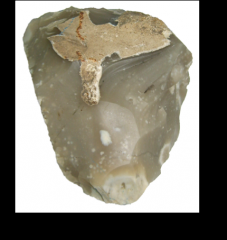
flint
|
A high silica content stone used to make stone tools through knapping. |
|
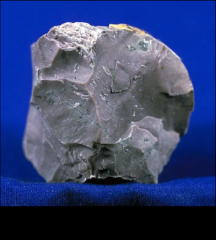
chert
|
A high silica content stone used to make stone tools through knapping. |
|

obsidian
|
Volcanic glass (igneous stone) used to make fine, sharp stone tools because of it high silica content. |
|
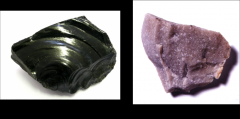
quartzite
|
A hard metamorphic rock used to make stone tools. |
|

basalt
|
A dark-colored, fine-grained igneous rock used to make stone tools. |
|

knapping
|
Working stone tools through a variety of techniques including flaking and hammering. |
|
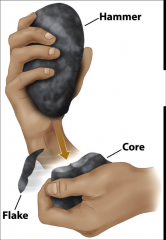
core
|
The raw material source (a river cobble or large flake) from which flakes are removed to create stone tools. |
|
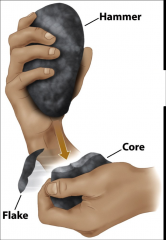
flake
|
A stone fragment struck from a core |
|
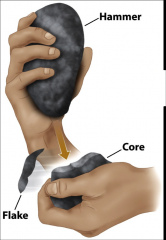
hammer
|
A stone used for striking cores to produce flakes |
|
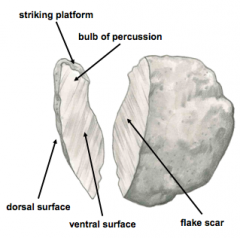
striking platform
|
Where the flake is struck |
|
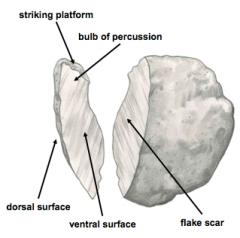
dorsal surface
|
The surface external to the core (either the external surface of the core or flake scars from previous flakes) |
|
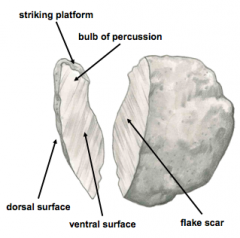
ventral surface
|
Surface near the core (typically smooth) |
|
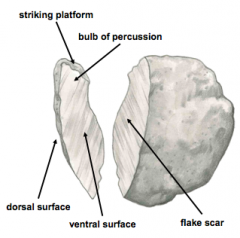
bulb of percussion
|
Just below the striking platform on the ventral surface (radiating ripples go down the flake) |
|

flake scar
|
What is left on the core after removing a flake |
|
|
direct percussion
|
Using an object to strike a core |
|
|
indirect percussion
|
Using an intermediate object to strike a core to produce finely made blades |
|

pressure flaking
|
Applying pressure to a core to remove a flake without hitting it. This removes long, thin flakes. |
|
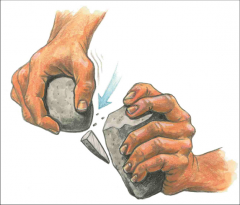
hard hammer
|
Using a hammer stone to knock off flakes (produces large, coarse flakes) |
|
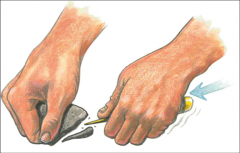
soft hammer
|
Using a bone, antler, or hard piece of wood to knock off flakes |
|
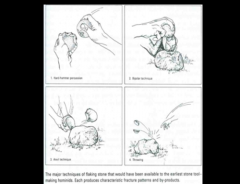
anvil technique
|
Striking a core against an anvil to knock off a flake |
|
|
tool industry
|
A particular style or tradition of making stone tools. |
|
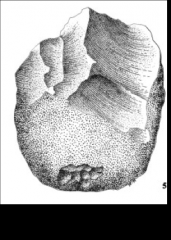
Oldowan
|
The name is derived from Olduvai, the first site where tools of this type were found. It consists of roughly fashioned chopper and discoid tools and flakes. They are found 2.6-2.5 Ma in Kada Gona and Bouri, Ethiopia; 2.4-2.3 Ma at Omo, Ehtiopia, and 2.0-1.6 Ma at Olduvai Gorge, Tanzania, Koobi Fora, Kenya, Swartkrans, South Africa, and Sterkfontein, South Africa. It is unclear who made the Olduwan tools, though it seems most likely to have been Australopithecus garhi, the Paranthropus genera, and early Homo. |
|
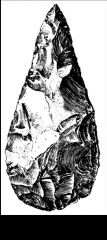
Acheulean
|
Tool industry employed by Homo erectus and characterized by distinctive oval and pear-shaped "hand axes" |
|
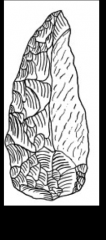
Mousterian
|
Tool industry employed by Homo neanderthalensis and made predominantly out of flint, sometimes employing the extremely complex Levallois technique. |
|
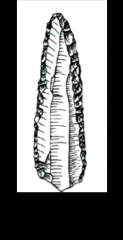
Upper Paleolithic
|
Tool industry employed by early Homo sapiens |

